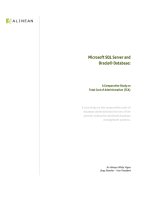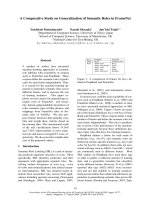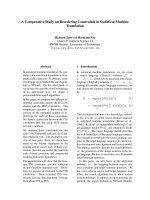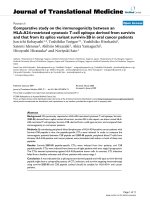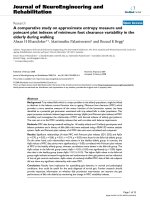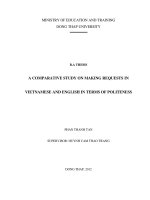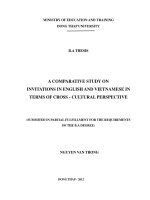Comparative study on growth, feed consumption
Bạn đang xem bản rút gọn của tài liệu. Xem và tải ngay bản đầy đủ của tài liệu tại đây (178.7 KB, 5 trang )
Indian Journal of Geo-Marine Science
Vol.44(7), July 2015, pp. 1120-1124
Comparative Study on Growth, Feed Consumption and Survival of Spiral
babylon Babylonia spirata Linnaeus, 1758 (Mollusca: Gastropoda) Fed with
Formulated Diets
G. Chelladurai*1, J. Mohanraj1 & M.Sasirekha Mani2
1
Department of Zoology, Kamaraj College, Tuticorin, Tamilnadu, India.
2
CAS in Botany, University of Madras, Guindy Campus, Chennai, Tamilnadu, India.
*[E.Mail ]
Received 26 November 2013; revised 25 March 2014
A growth trial was conducted to determine the effects of the dietary protein level on growth, feed utilization and survival of
Babylonia spirata. Triplicate groups of 50 animals (with an initial average weight of 49.24 ± 0.8 g) were stocked in 50-l tanks and fed to
apparent satiation twice daily for three months with two experimental diets of 30% and 40% protein content and control diet of fresh meat
clam. Growth of snails that were fed with natural food was not significantly (P<0.05) higher than those fed with the experimental diets.
There was no significant difference (P>0.05) in growth and Feed Conversion Ratio between snails that were fed with experimental diets.
Present study infers that a diet containing 30% and 40% of protein content may be recommended for the growth of B. spirata.
Key words: Babylonia spirata, Formulated feed, Clam, Growth performance]
Introduction
The phylum Mollusca comprises the largest and
diverse class Gastropoda with approximately 75,000
existing species and about 15,000 fossil forms
according to the back of cambium. Spiral Babylon
snail Babylonia spirata (Linnaeus, 1758) is a
commercial gastropod that is in high demand in
China, Japan, Taiwan and India1,2. This gastropod is a
good prospect for commercial aquaculture due to its
resistance to the environment. It is important to
develop a cost-effective and nutritionally balance feed
formulation for this species in the future3,4.
Establishment of a successful aquaculture industry
based on this species will require optimization of their
diet for fast growth and survival, while maintaining a
good proximate composition in the flesh. It
commands a high price and has a relatively simple
culture technique in comparison with other
gastropods5,6,7. Market demand for this gastropod is
rapidly increasing due to the sharp decline in natural
stock due to overfishing. Therefore, the culture of
spiral Babylon snail is important to meet the market
demand and for the development of natural wild
stock. The artificial diets allow mechanized
production8, result in increased survival rates9 and
generally produce better growth in weight and length
than natural food. The slow growth and poor survival
of spiral Babylon’s resulting from inappropriate or
inadequate food supply during the growing-out period
will prolong holding time and increase hatchery
expenditure. Nowadays, the lack of research and
development on appropriate feeds to culturing spiral
Babylon is a major constraint for malacological
studies. The artificial feed formulation and
preparation is to provide for optimal nutrition for B.
spirata at the lowest possible cost. In reality, however
the diet development is normally a compromise
between this ideal situation and practical
considerations, such as the cost of ingredients, pellet
ability, and diet acceptability, water stability of the
feed and handling requirement10.
Materials and Methods
Two experimental diets were formulated to contain
protein level of 30% and 40%. The formulations of
the experimental diets and their proximate
composition are shown in (Table 1). Fishmeal and
fish oil were used as the protein and lipid sources and
CHELLADURAI et al.: COMPARATIVE STUDY ON GROWTH, FEED CONSUMPTION
Tapioca was used as the carbohydrate source and
wheat starch was used as the binder, respectively.
Procedures for food preparation were modified11. The
feed ingredients were homogenized thoroughly in a
food mixer. After adding water to the mixed
ingredients, a paste was made using a hand mixer.
Paste was shaped into 0.5 mm thick sheets, cut into 2
cm2 flakes, sealed in a plastic bag and stored at –20℃
until use. The dry feed samples were analysed for
proximate composition following the standard12.
Babylonia spirata (Buccinidae) were collected at the
Therispuram coastal area (80 48´N; 780 94´E),
Tamilnadu, Southeast coast of India (Figure 1). They
were reared in rectangular tanks of 1.5 x 0.5 x 0.5 m
(L: W: H), supplied with flow-through natural,
aerated ambient seawater. Bottom of the rearing
tanks was covered with a 3 cm layer of coarse sand
(250 to 500 micron mean grain size) as substrate.
After removing the snails from the culture tanks, sand
was then cleaned using a water jet flushing then sun
dried for 6 hours at 30-day intervals to remove
accumulated waste materials. Temperature and
salinity ranged from 28 to 30°C and 28 to 29 ppt,
respectively. These parameters were examined by
using SYSTRONICS water analyser 371.
Feeding treatments were randomly allocated to each
tank (three replicates per treatment).The initial mean
total weight and shell length of snails was 49.24 ± 0.8
g and 5.40 ± 0.1cm respectively. Initial stocking
density was 50 snails per tank. The experimental
groups were fed with formulated diet and control
group were fed with fresh clam twice daily at 09:00
am and 04:00 pm. Amount of feed consumed by the
snails in each tank was recorded daily. The total
experiment was conducted for 90 days. Twenty
randomly selected snails per tank from each treatment
were measured for their total weight and shell length
every 30 days and returned to the tank. The mean
monthly growth rates (g) were calculated from
average increments in shell size and weight according
to the formula.
Growth performance and nutrient utilization
were expressed in terms of weight measurements,
weight gain (WG), specific growth rate (SGR),
survival rate and feed conversion ratio (FCR), as
follows:
Total weight =
final weight - Initial weight.
1121
Total length =
Weight gain =
final length - Initial length.
W2 – W1 (W2 = mean final
weight, W1 = mean initial
weight)
Feed Consumed /
Feed Conversion Ratio =
Live Weight Gain
Specfic Growth Rate = (ln W2 – ln W1 /T) × 100
(W2 = final weight, W1 = initial weight, T =
experimental period (day))
Survival (%)
=
F2 / F1 × 100
(F1 = number of snail at the beginning of
experiment, F2= umber of snail at the end of the
experiment).
All calculations were based on the triplicate tank
treatment.
Fig. 1- Map showing the study area
Statistical analysis
Data analysis was performed by one-way
analysis of variance (ANOVA) using SPSS version
12.0. The data were subjected to an analysis of
variance and Duncan multiple-range test and was used
to evaluate specific differences between treatments
test at 5% probability level. Differences were
considered significant at p<0.05.
Results
Growth of snails fed with natural food was not
significantly (P<0.05) higher than those snails fed
with the experimental diets. Besides, no significant
difference (P>0.05) in growth was found between the
snails fed with experiment diets of 30% and 40%
protein contents. The weight gain of snails was 2.21
g, 2.38 g and 3.92 g for snails fed with experimental
diets of 30% and 40% protein contents and natural
food, respectively. The specific growth rate (SGR) of
snails was 1.11 g, 1.31 g and 1.73 g for experimental
diets of 30% and 40% and control, respectively. No
1122
INDIAN J MAR SCI. VOL 44 , NO.7,JULY 2015
significant difference (P>0.05) was observed in feed
conversion ratio (FCR) between the feeding
treatments (Table 2). Over the period of experimenthe
survival exceeded 95% for all treatments and did not
appear to be affected by dietary protein.
Discussion
The present study showed that differences in the
growth and feed conversion ratio of B. spirata fed
with experimental diets of 30% and 40% protein
contents and natural food are relatively small.
Survival was 100% for feeding diet treatments, based
on the present data. The B. spirata fed on the
formulated diets produced good results in growth of
weight gain, length increment, FCR and survival,
which are similar to those fed with the natural diet
Similarly the other authors have reported the higher
growth and low FCR with increasing protein content
of formulated diet for abalones13,14. This study
suggests that the formulated diet is considered to be
suitable for growing out of B. spirata over a period of
90 days due to its ready for acceptance of formulated
feeds with a relatively rapid
Table
TablC
1-
S.No
1
2
3
4
5
6
Composition of the basal diet
Ingredients
Fish meal
*
GOC
Tapioca flour
Maida
Fish oil
Vitamine&Mineral
Tablet premix
Proximate composition (%)
Protein
Carbohydrate
Lipid
*
Ground nut oilcake
Artificial diets may be much better than plant diets to
increase growth in cultured snails. The artificial diet
associated with plants resulted in great grown and
earlier sexual maturity than artificial food without
plants or plants alone in Achatina fulica16,17. However,
no information on the nutritional requirements of
spiral Babylon under controlled conditions has been
reported. The present study indicates that artificial
diets are accepted for the culture system of spiral
Babylon and suitable candidate for mariculture due to
its ready acceptance of formulated feeds that promote
a relatively rapid growth rate, low FCR and high
survival.
Acknowledgement
The authors are thankful to the CMLRE-Project
(Grant No. MoES/10-MLR/01/12) Ministry of Earth
Sciences (MoEs),Government of India, Kochi for
financial assistance. We are grateful to the authorities
of Kamaraj College, Manonmaniam Sundaranar
University for support and encouragement
.
Control
30%(Diet 1)
40% (Diet 2)
-
30
35
18
15
1
1
45
35
10
8
1
1
71.76
25.54
3.89
30.56
22.89
2.11
40.72
19.43
2.89
1123
CHELLADURAI et al.: COMPARATIVE STUDY ON GROWTH, FEED CONSUMPTION
Table 2 Average growth parameters of B. spirata fed with experimental diets.
Parameters
Initial
weight
(g)
Final weight
(g)
Initial length
(cm)
initial
Length
(cm)
Weight
Gain
(g)
FCR
SGR
(g)
Survival
(%)
Control
52.20±0.91a
56.12± 0.23a
5.76±1.04a
6.13±0.12b
3.92±0.07a
1.06±0.11
a
1.73±0.08b
100
Diet 1
50.12±0.23b
52.24±0.19a
5.40±0.53a
5.51±0.11b
2.12±0.09c
1.37±0.14
1.11±0.14a
94
Diet2
51.51±1.08c
53.89±1.07a
5.40±1.09b
5.69±0.19b
2.38±0.13a
1.39±0.01
1.33±0.05a
96
a
a
a,b
All values are means of three replicates ± SD for triplicate feeding groups and values in the same row with different superscripts are
significantly different (p<0.05)
6
References
1
2
Chaitanawisuti N, Kritsanapuntu A & Natsukari
Y, Economic analysis of a pilot commercial
production for spotted babylon, Babylonia areolata
(Link 1807) of marketable sizes using a flowthrough culture system in Thailand. Aquaculture
Research, 33 (2002a): 1265-1272.
Chen Y, Ke CH, Zhou SH & Li FH, Effect of food
availability on feeding and growth of cultivated
Juvenile Babylonia Formosae habei (Altena and
Gittenberger1981).Aquaculture
research,
36
(2005):94-99.
3
Chaitanawisuti, N & Kritsanapuntu, A, Effects of
different feeding regimes on growth, survival and
feed conversion of hatchery-reared juveniles of the
gastropod mollusc spotted babylon Babylonia
areolata (Link 1807) in flowthrough culture
systems. Aquacult. Res. 30(1999) 589-593.
4
Zhou J B , Zhou Q C , Chi S Y , Yang Q H &
Liu C W, Optimal dietary protein requirement for
Juvenile ivory Shell,
Babylonia. Aquaculture,
270 (2007):186-192.
5
Owen G, Feeding. In: Physiology of Mollusca. Vol.
2. (Eds.) K. Wilbur & C.M. Yonge, pp. I-52.
Academic Press, New York. Purchon, R.D. 1977.
7
8
Kohn A J, Feeding biology of gastropods. In: The
Mollusca. Vol. 2: Physiology, Part I. (Eds.) A S ,
M. Saleuddin & K.M. Wilbur, pp. 1:63 (1983).
Hawkins S J, McCrohan, C R & Taylor D, 1989.
Introduction to: Gastropod Feeding biology - an
Integrated View.J. Mollusc .Stud.,55 (1989) 149.
Hahn KO, Nutrition and growth of abalone In:
Handbook of Culture of Abalone and other Marine
Gastropods. (Ed.) K.O. Hahn, pp (1989a) 135-182.
9
Hahn KO, Culture of Haliotis tuberculata at the
Argenton Experimental Station, France. In:
Handbook of Culture of Abalone and Other Marine
Gastropods. (Ed.) K.O. Hahn, pp. (1989b) 285294.
10 Hardy R W, Diet preparation. In: Fish Nutrition.
2nd ed. (Ed.) J.E. Halver, pp (1989) 476-548,
Academic Press, San Diego.
11 Creswell L,. Ingestion, assimilation, and growth of
juveniles of the queen conch Strombus gigas Linne
fed experimental diets. Journal of Shellfish
Research 4(1984):23–30.
12 Britz PJ & T. Hecht, Effect of dietary protein and
energy level on growth and body composition of
South
African
abalone,
Haliotis
midae.
Aquaculture 156 (1997):195–210.
1124
INDIAN J MAR SCI. VOL 44 , NO.7,JULY 2015
13 Chaitanawisuti N & A. Kritsanapuntu, Growth and
survival of hatchery-reared juvenile spotted
babylon, Babylonia areolata (Neogastropoda:
Buccinidae) in four nursery culture conditions. J.
Shellfish Research. 17:1 (1998): 85-88.
14 Ritz S, Helmer K J & Hecht M H, Detecting Native
like Properties in Combinatorial Libraries of De
Novo Proteins. Folding & Design 2, (1996):89-92.
15
Ribas J, Criaço de Caracis – nova opção economic
abrasileira.S o Paulo, Nobel, 123P (1986).
16 Monney K A, Effects of different dietary regimes
on growth and reproductive function of farmed
Achatina fulica Bowdich. Snail farming research
5(1994):14-22.
